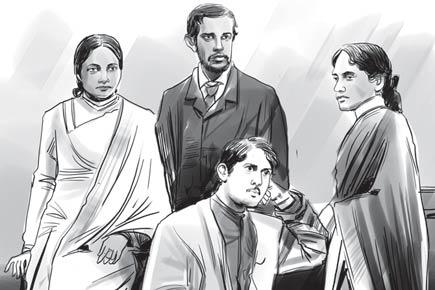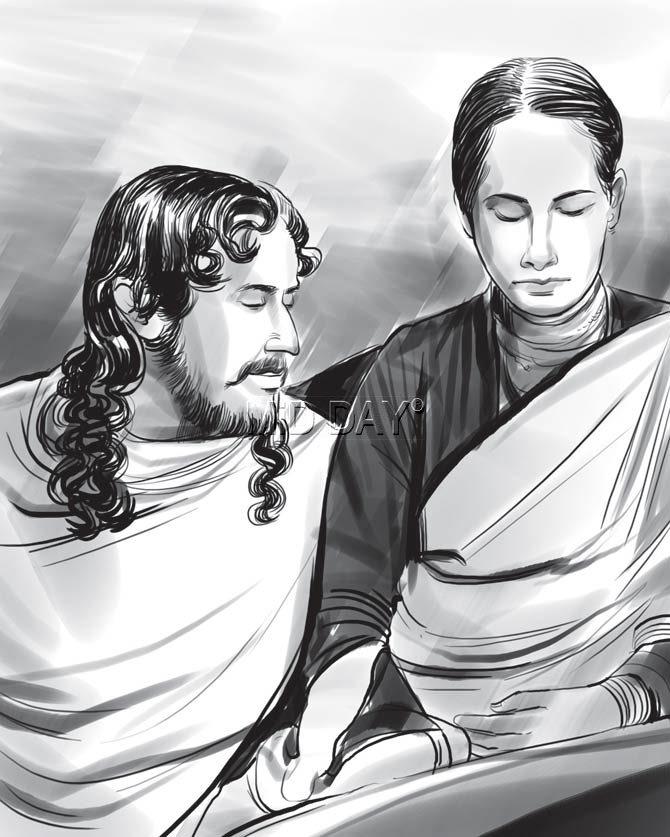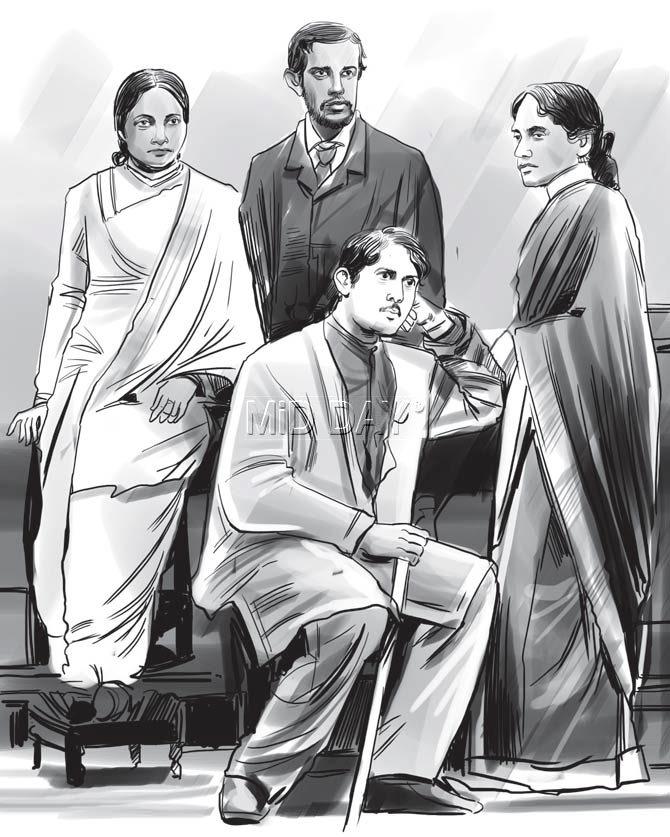A new book offers a bold insight into the lives and times of the women who influenced and inspired Rabindranath Tagore in his literary pursuits


A sketch of Rabindranath Tagore with his wife Mrinalini
With every page turn, Aruna Chakravarti’s book Daughters of Jorasanko recreates the era between 1859 and 1902, engaging us with stories of Jnanadanandini, the wife of Rabindranath Tagore’s elder brother Satyendranath, who was a strong influence in the nobel laureate’s life. There are also part-fictional accounts of the lives of his other sister-in-law, Kadambari, his wife Mrinalini and the many women who influenced him. The story is set in Jorasanko, the ancestral home of the Tagores. “The brilliant women of the family have remained hidden in the shadows while the men have basked in limelight,” says Chakravarti. The book is a sequel to Chakravarti’s 2013 title, Jorasanko. Excerpts from a chat with the author:

Members of the Tagore family. (Sitting) Jyotirindranath Tagore; (standing from right) Kadambari, wife of Jyotirindranath, Satyendranath Tagore and Jnanadanandini, wife of Satyendranath. Illustrations/Uday mohite
The book talks extensively of how Tagore flourished under the influence of his sisters-in-law.
Jnanadanandini was a self-educated woman who had many firsts to her credit. She was the first Bengali woman to attend the Governor General’s reception, that too without her husband, and the first to move out of her extended household and set up a nuclear establishment. She invented the modern way of wearing the sari, which gave Bengal’s women a civilised sartorial style and an upright posture. Kadambari was Rabindranath’s muse and a sharp-yet-sensitive critic of his work. Though she didn’t write poetry herself, her understanding of it was astounding. The poet has acknowledged his debt to her in his writings. Unfortunately, she had a streak of depression, and committed suicide at 23.

Aruna Chakravarti
What did you learn about Tagore’s spouse Mrinalini?
Mrinalini, though less known than her two sisters-in-law, influenced her husband and her times, too. History has been unkind to her. She was not an ‘unworthy spouse’ if one considers the restrictions on the women of her time. Married at 10, she took advantage of the somewhat liberal atmosphere of Jorasanko and learnt some English. But she was never ambitious and remained her husband’s support throughout. She gave all to help Rabindranath establish
a school in Santiniketan.
Are we scared to probe the grey areas in our icons’ lives?
Yes. We tend to deify our great men and women. The Tagore family is highly revered and most writers fight shy of saying anything faintly critical about them. But I wanted to portray the members of the family as human beings with their frailties, which, has not taken away from their greatness. Rabindranath made many mistakes in his life, but he recognised them and tried to atone for them. I have not been afraid to ruffle feathers.
Which part of Rabindranath’s personality fascinates you the most?
Rabindranath (the character that I have created) has a habit of taking stock of himself from time to time, of recognizing his mistakes and atoning for them. This is what fascinates me the most as does his complete absence of ego. He was impulsive and careless at times and made bad choices. He neglected his wife, married his daughters to the wrong men and wasn’t there for Kadambari on the night she took her life. But he never made excuses for his actions. He faced them fairly and with humility, and tried to make up for them as best as he could.
What is the fictional part of the book?
There are no fictional characters in my book. Barring a few peripheral ones like the fishwife Ullashi, the servant Brindaban, the coachman Hakim Ali who make brief single appearances, all the characters are located in biography. There are no external plot lines either. The main events are based on recorded facts. The fictional element lies in the stringing together of these facts; in giving them a narrative flow. The creative imagination is employed to portray moods, gestures, thoughts, dreams and aspirations of historically documented men and women as well as in details like the clothes they wear, the spaces they occupy -- both physical and spiritual -- the way they speak, the food they eat, etc. I did not plan any fact/fiction ratio, so whatever I have written has flowed spontaneously.
What kind of research did you have to do for it? How long did it take?
My basic research was from the biographies of Tagore by two eminent scholars Proshanta Kumar Pal and Prabhat Mukhopadhyay. Their work is extensive running into many volumes. However, it is almost entirely focused on Rabindranath’s life and work. References to the women are few and far between. Fortunately, some of the women have written autobiographies and articles like Sarala Debi’s book Jeebaner Jhara Pata, Indira Debi’s Smriti Samput and the collection of letters she exchanged with the poet that provided rich sources of information. Other books like Rabindranath er Atmiyan Swajan by Sameer Gupta and Thakur Barir Andarmahal by Chitra Deb; books by other members of the Tagore family including Rabindranath himself and those of other Tagore scholars provided information. The research took me about three years for both the books.
 Subscribe today by clicking the link and stay updated with the latest news!" Click here!
Subscribe today by clicking the link and stay updated with the latest news!" Click here!









